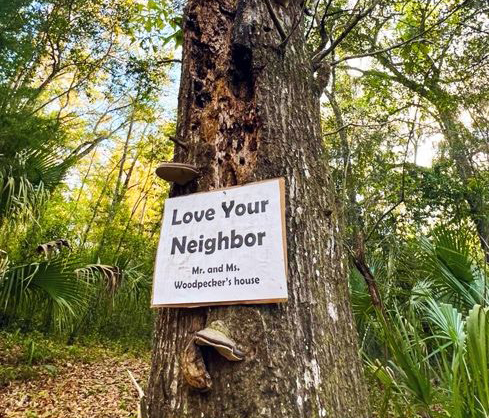A Valentine You Can Send to Nature!

I’m blogging this February 14th to report that recently I underwent an actual bona fide 180 on one of my opinions! This was an almost entirely new experience for me because, like most people, I’m right almost all of the time. So it seems like news worth sharing.
My original opinion that changed (!) was that the neighbors down the street from my friend’s house had cheaped out on their tree service people. I happen to know, having had a tree removed from my own yard a couple of years ago, that it costs a lot more to have the entire tree, stump and all, removed. (The tree in Q was: 1. an invasive species that was sending out runners into abutting yards and threatening to take over the neighborhood; and 2. planted too close to the house so that its luscious, leafy limbs draped low over the roof for a lovely, “cottage-in-the-woods” effect and nestled closely against the roof tiles every single time it rained, eventually creating a picturesque indoor waterfall down a bedroom wall and necessitating a roof replacement that cost me so many thousands of dollars it hurts too much to type the actual number.)
So, knowing a little bit about tree-removal pricing, when I saw the ten- or fifteen-foot tree trunks with their crowns lopped off in my friends’ neighbors’ yard and then began spotting similar lopped-off trees in yards all around town, I thought probably area homeowners had been sacrificing aesthetics to economy.
Oops…
A very sweet recent publication on Ask IFAS, Woodpecker Poles and Habitat Wood in Your Yard, has taught me better. When I read it, I learned that those crown-free tree trunks I had been turning up my nose at are woodpecker poles, and that they’re a form of something called habitat wood. The kind-hearted people of my town were leaving tree trunks in their yards on purpose to provide food and lodging for wildlife. It’s funny how coming to a better understanding of something helps you to appreciate that thing. When I learned that the lopped-off trees all over town are in fact making our town more hospitable for birds and animals, those tree trunks instantly became beautiful to me.

Habitat Wood
Many animals need both dead wood and living trees. You can leave dead trees or parts of trees in your yard to make your yard more hospitable for those animals. Habitat wood increases biodiversity and boosts the health of a landscape by improving the soil and creating food and shelter for birds, animals, fungi, and insects. Snags, fallen logs, and old woodpiles, as well as the least-expensive tree removal option on your tree service’s price list all count.
If you would like to send a Valentine’s Day love letter to a woodpecker or a flying squirrel near you, check out Benjamin Schwartz, Jiri Hulcr, Andrew Koeser, and Stan Rosenthal’s charming Woodpecker Poles and Habitat Wood in Your Yard. This handy guide will show you how to safely incorporate wildlife poles and other forms of habitat wood in your landscape. Learn more about how to show love to urban critters in your area from publications in the Landscaping for Florida Wildlife category on Ask IFAS (scroll down).

 3
3
